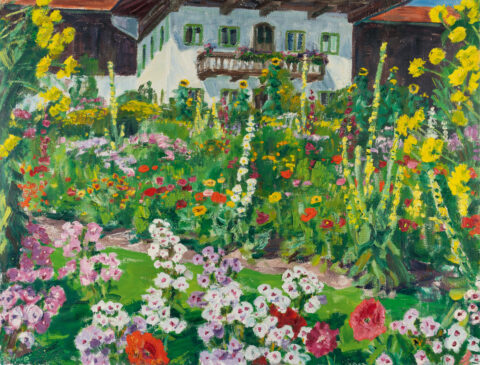
Bouquet against pink background
Details
Inscribed by an unknown hand on the reverse on the stretcher.
Exhibitions: Arnold Balwé 1898-1983. Elisabeth Balwé-Staimmer 1896-1973. Gedächtnisausstellung, Galerie im Alten Rathaus, Prien a. Chiemsee 1988, cat. no.22, with full page black and white ill.
Provenance: From the artist’s estate.
Description
Arnold Balwé was born in Dresden on 29 March 1898, the son of a Dutch consul, and spent his early youth in South Africa. In 1917, he completed his school education in Würzburg with the Abitur. In 1918/19 he worked as a trainee in agriculture in Lower Bavaria and in an architect’s office, and as early as 1918 he met the painter Elisabeth Staimmer, whom he married in 1927 and who shared his passion for painting for the rest of her life. In 1920 he was accepted as a student of Professors Gogo and Opsomer at the Antwerp Academy and spent 1921 in Rome and travelled through Italy. Even then, he was fascinated by the light of the south, which would inspire him to create numerous works. From 1922 to 1927, he studied in Munich under Professor Karl Caspar and received several awards, including the Alexander von Humboldt Prize. Balwé was one of Caspar’s most important students and developed his own unmistakable style through personal contact with his teacher. During these years, he settled in Munich and Feldwies am Chiemsee and repeatedly undertook longer study trips through Europe. The garden of his farmhouse in Feldwies inspired him to make numerous summer studies of the lush plant world, which he also incorporated into works of everyday life, and from 1928 he took part in exhibitions of the New Secession in the Glaspalast and later annually in the Haus der Kunst. He took part in exhibitions organised by the Rhenish Secession associations in Düsseldorf, Augsburg, Regensburg, Hanover and Basel. During the Nazi dictatorship, Balwé was also affected by the confiscation of individual works. Shortly after the Second World War, the first exhibition took place in Prien am Chiemsee in 1945/46. In 1949, Balwé was finally honoured in a collective exhibition at the Städtische Galerie im Lenbachhaus in Munich, and from 1950 to 1967, Balwé exhibited regularly in German cities, including the Kunstverein München and, until 1983, annually with the Neue Gruppe at the Haus der Kunst. Balwé died on 20 January 1983 in Prien am Chiemsee. In 1982, he was awarded the Upper Bavarian Culture Prize. After his death, he was honoured with a memorial exhibition in Prien in 1988. Throughout his life, Balwé’s works were characterised by a strong, impasto style, which he built up entirely from colour. Balwé’s love for his homeland in Chiemgau, his love of travelling through Europe and his love for his family, some of which provides very private insights, can be seen in his works. The broad facet of Balwé’s oeuvre is shown on the following pages. The works were entrusted to Karl & Faber from his estate.
* All results incl. buyer’s premium (27%) without VAT. No guarantee, subject to error.
** All post-auction prices excl. buyer's premium and VAT. No guarantee, subject to error.
*** Conditional Sale: The bid was accepted below the limit. Acquisition of the work may still be possible in our post-auction sale.
R = regular taxation
N = differential taxation on works of art which originate from a country outside of the EU
The private or commercial use of images shown on this Website, in particular through duplication or dissemination, is not permitted. All rights reserved.


